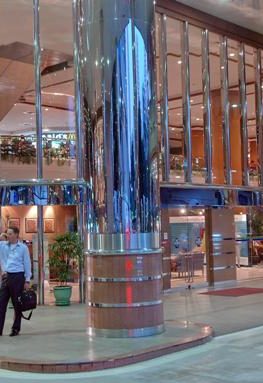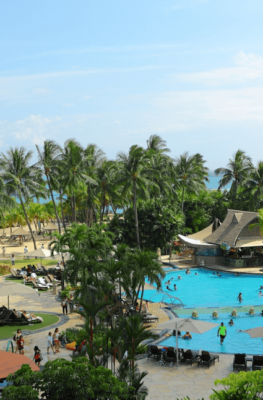Published on November 16, 2017

Swimming with whale sharks in the Philippines. Image courtesy of Mike Aquino.
Come on in, the water’s fine! There’s water all around you in Southeast Asia; its beaches are famous enough for activities like scuba diving and surfing, but even inland, you can find aquatic adventure waiting for you thanks to an endless assortment of river activities.
We asked bloggers to tell us about their favorite water-based adventures in the region, and three stepped up to share – Brianne Miers talked to us about snorkeling with dolphins and whale sharks in the Philippines’ Honda Bay; Claire Madarang recounted her experience tubing down Vang Vieng in Laos; and Cat Lin told us about her Gili Islands scuba-diving trip in Indonesia.
Ethical Whale Shark Encounters in Palawan, Philippines
Snorkeling with whale sharks in the Philippines has lately gotten some flak from concerned parties, so when Brienne Miers heard about the whale shark experience in Honda Bay, Palawan, the plan was a tough sell.
“I was skeptical,” Brienne recalls. “As a blogger who focuses on responsible travel, I didn’t want to participate in an experience that wasn’t in the best interests of local wildlife.”
Unlike other whale shark experiences, the Honda Bay trip was different, she was told – “the whale sharks are in their natural habitat and not fed, touched or interacted with in any way,” she says. “Even better, Dolphin and Whales Travel and Tours is a locally owned and operated company – the first tour company in the area to run whale shark swimming tours in Honda Bay, starting about 10 years ago.”
On the trip going to the drop-off point, Brianne and her dozen or so compatriots were issued masks and snorkels, then dropped off the side of the boat after an hour’s motoring into Honda Bay.
In Palawan, whale sharks aren’t baited to come close to visitors – the visitors come to them. The tour operators use spotters to find these giant fish: “they use the presence of birds and fish to determine where the whale sharks are feeding,” Brianne tells us. “Needless to say, they have excellent eyesight!”
Once in the water, paddling in search of nearby whale sharks was harder than Brianne initially thought. “When we heard the guides scream, ‘Whale shark! Whale shark!’ we’d all frantically scramble into the water and start paddling around – trying not to push or kick each other in the process – to try and see the whale shark (or group of whale sharks) for ourselves,” she recalled.
“It was equally terrifying and enthralling to be so close to these gigantic, peaceful creatures,” she says, recalling the encounter as one of the highlights of her two-week trip to the Philippines. “They’d swim right beneath you, so close that you could easily reach out and pet them (Of course, we didn’t!).”

Kayaking down Nam Song River in Vang Vieng, Laos. Image courtesy of Claire Madarang.
Tubing Down a River in Vang Vieng, Laos
The tourist scene in Vang Vieng, Laos was once quite rowdy and carefree, until the government stepped in to tame the Wild West the riverside town had become. With most (not all) of the bars closed and the river activities reformed, Vang Vieng is now much less about the partying and far more about the river and the gorgeous scenery beyond.
Claire Madarang went to Vang Vieng on the strength of its revitalized reputation – “Vang Vieng is arguably most popular for tubing, particularly in Nam Song River,” Claire explains. Claire booked an adventure tour through her hostel, one that included trekking, cave tubing and river kayaking – the river activities were the best of the lot, Claire recalls.
“It was refreshing seeing cave formations while idly floating around on my tube, and seeing the clear blue-green water underneath as we entered and exited the cave,” Claire explains. “Later, our group paddled on kayaks while taking in Vang Vieng’s forest-covered limestone formations in the distance.”
The bar scene has not completely left the riverside – “[Nam Song’s] six-kilometer tubing route is occasionally lined with outdoor bars the tuber can stop by,” she explains. “At some point, we parked our kayaks to have a few drinks in one of the outdoor bars.”

Turtle off Gili Islands, Indonesia. Image courtesy of Chris Northey/Creative Commons
Scuba Diving off the Gili Islands, Indonesia
Cat Lin visited the Gili Islands near Bali, Indonesia with her husband, fully expecting to enjoy the resorts and the beach. She soon found out that the Gilis were as much fun under the water as they were above.
“We went scuba diving near Gili Meno,” Cat recalls. “We found our dive shop (Blue Marine Dive) through the place we stayed at (Slow Gili Air).”
The Gili dive shops drive a good bargain, almost unbeatable given the richness and variety of the dive spots nearby. “[The packages were] relatively cheap compared to other parts of Asia and North America,” Cat recalls. “Once you’re on the island, it’s all fixed price due to the price agreement between the dive centres.”
Visiting with no equipment? No worries, the Gili dive shops “provide everything you need for scuba-diving, including fins, mask, BCD and regulator, weights, wetsuit, etc.,” Cat says. Visiting with no prior scuba-diving experience? Not a problem either: “you can take a course with their PADI instructor too!” Cat explains. “My husband did a scuba course while we were there – all it took was two full days.”
There are at least 26 dive sites around the Gili Islands, and the sites that Cat and her husband visited took their breath away. “[I saw] corals, puffer fish, bat fish, moray eels and tons of turtles!” she gushes. “At Turtle Heaven, we swam with as many as 20 turtles!”
The laid-back atmosphere of the Gilis captivated Cat completely – “it is much less crowded than Bali,” she says, recommending the Gilis to “those who want to get away from the hectic pace of modern life and have an affection for nature.”
Even if diving isn’t your bag, you can enjoy yourself in the Gilis the way Cat and her hubby did: “Biking around the island, practicing yoga, and treating ourselves to massages!”
* * * *
Brianne Miers blogs at a Traveling Life. you can follow her adventures on her blog’s social media channels: Facebook, Instagram and Twitter.
Stay abreast of Claire Madarang’s adventures on her site Traveling Light, or do the same on her social media profiles: Facebook, Twitter and Instagram.
Cat Lin’s blog For Two, Please has the latest on her adventures traveling with her husband. Follow Cat on social media: Facebook, Instagram and Twitter.






